Agile mindset: 5 steps to becoming an agile organization
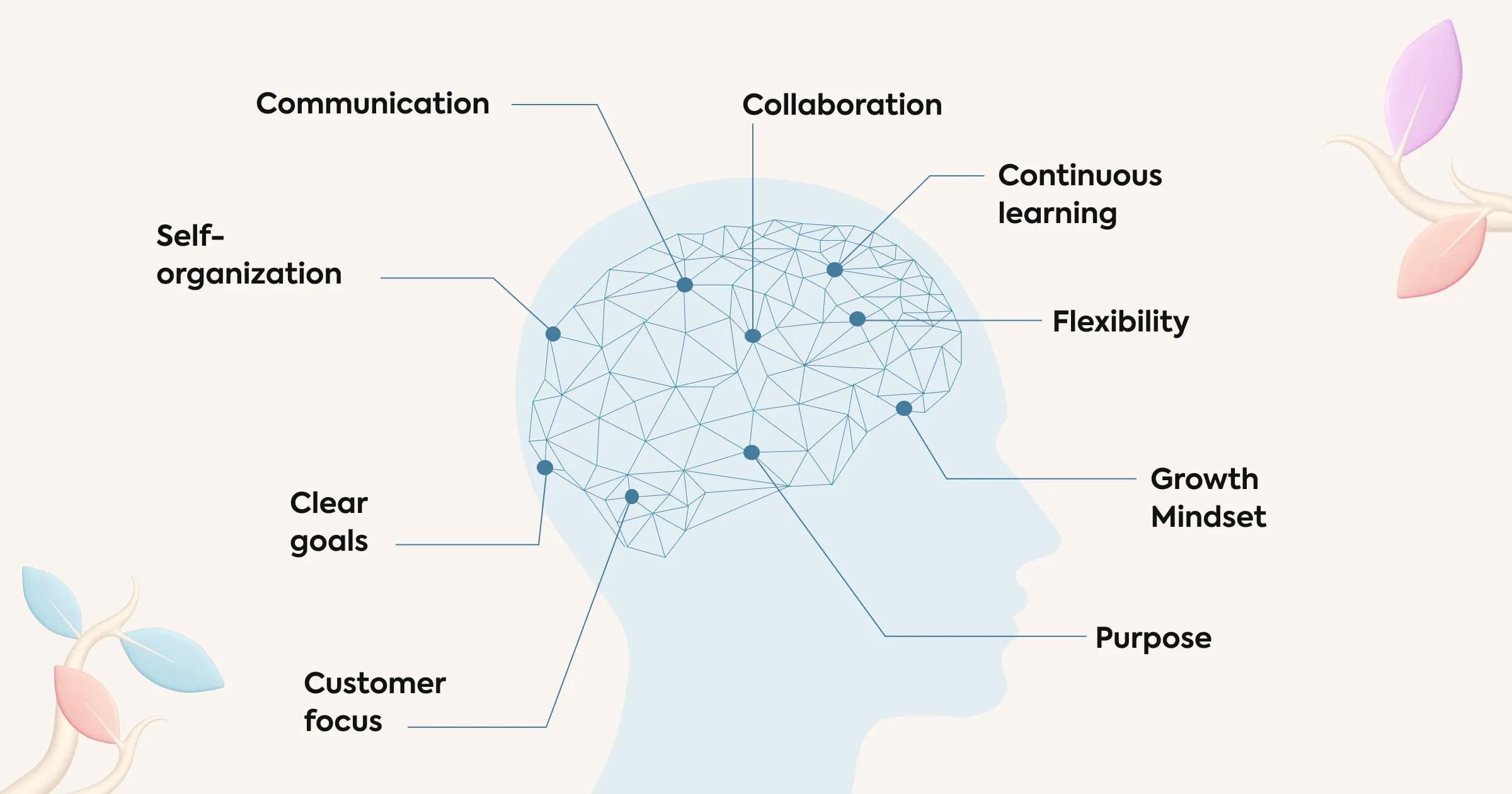
Our modern working world is characterized by agile practices and frameworks. The basis for this is an agile mindset. In this article, we explain what exactly lies behind it and what it takes for a company to develop an agile mindset.
What to expect:
- What is an agile mindset? Definition
- Why is an agile mindset important?
- Becoming agile without an agile mindset – possible or not?
- Developing an agile mindset as a company – tips and trademarks
- Practical check: How can companies tell if they have an agile mindset?
- Conclusion: Doing agile vs. being agile – a matter of mindset
- Agile mindset – FAQ
What is an agile mindset? Definition
The term “mindset” can mean many different things: a way of thinking, attitude, or philosophy of life. Looking at this list, it becomes clear what mindset is all about: a person's (or company's) perspective on the world.
In general, there are many different ways of perceiving the world. An agile mindset means being flexible and adaptable. People (and companies) with an agile mindset are able to react quickly to changes, face challenges, reflect on their actions and continuously learn.
In summary, an agile mindset is a way of thinking or an attitude that leads to individuals or even entire companies having an agile understanding of values and, as a result, acting in an agile manner.
An agile mindset ensures that agility is lived successfully. It is therefore the invisible foundation of every truly agile organization.
Values and principles of the agile mindset
The understanding of values that results from an agile mindset is summarized in the “Agile Manifesto” in the form of twelve agile principles and four core values. Although these originated in software development, they can be adapted and transferred to almost any company and field.
💡 You can find more information about the values and principles of the agile manifesto in our “Agile Project Management Guide”.
Seven of these principles that are particularly closely linked to an agile mindset are:
- Self-organization
- Communication and feedback
- Clear, shared goals and vision
- Adaptability
- Focus on customer needs
- Collaboration
- Learning from mistakes
Central elements of an agile mindset
Basically, an agile mindset becomes visible on several levels: Being agile operates in a context of tension between people and work. At the same time, it is a question of perspective on a particular situation. More specifically, one distinguishes between self-image and external image.
This results in a total of four fields in which an agile mindset becomes tangible and distinguishable from a non-agile approach:
- Self-image in everyday life: How do I see myself?
- Self-image at work: How do I see my professional self?
- External image in everyday life: What is my attitude towards other people?
- External image at work: What is my general attitude towards work?
If we now take a closer look at the individual fields, the following elements can be identified as central to an agile mindset:
- 🌱 Growth mindset: Agility requires the willingness to change, to learn new things and to accept mistakes. Those who always move within their own comfort zone and avoid criticism (fixed mindset) are not agile.
- ✨ Self-realization: The basis for agility is people who think and act intrinsically motivated, responsibly and creatively. There is no room for micromanagement, control and pressure in the agile mindset.
- 🛃 Customer-centric thinking: People with an agile mindset use their own creative power primarily to create added value for customers.
- 💭 Purpose: Those who think and act in an agile way consider work to be a meaningful activity and recognize, for example, the social responsibility that comes with a job. It's about more than just earning money – no matter if it's for yourself or your company.
Why is an agile mindset important?
An agile mindset is important for many reasons – whether for companies or individuals, in project management or personal development, for managers or employees.
Employees are enabled to overcome challenges
Today, more than ever, everyday work is full of unforeseen changes and challenges. People with an agile mindset are able to master them.
For example, they are
- good at responding to change instead of going into shock,
- able to take different perspectives,
- able to find creative solutions,
- able to deal with conflict and accept criticism as a chance to learn,
- intrinsically motivated and work in a self-organized manner,
- able to take responsibility and make decisions.
Employees with an agile mindset tend to be willing to admit mistakes, never consider tasks to be impossible, wish for continuous improvement, and are always focused on growth. This makes them particularly valuable to a team and facilitates everyday work.
Companies become more flexible and innovative
In today's VUCA working world, however, an agile mindset is also a fundamental requirement for companies to prevail against competitors and remain competitive. Otherwise, if developments are slept through and opportunities are not recognized, you will quickly lag behind the competition and fall into oblivion.
With an agile mindset, on the other hand, organizations become
- more decisive,
- diverse and
- flexible.
The fact that agile organizations are characterized by a higher degree of self-determination often also increases employee satisfaction and strengthens employee loyalty to the company.
Finally, an agile mindset also implies that employees are good at dealing with change. This means that innovations are generally easier to implement in companies with agile teams. This clears the way for innovative and visionary business ideas.
💡 Tip: If you want to learn more about the benefits of agility for companies and what constitutes an agile organization, you should also read our article on the topic of “Agile organization: Benefits, characteristics and methods”.
Becoming agile without an agile mindset – possible or not?
Without the right mindset, companies will not get very far in their agile transformation. If you simply pick an agile framework, such as Scrum, Design Thinking or OKRs, implement agile processes and use the tools provided with these agile methods, you are far from being agile.
After all, agile frameworks, tools and management methods only work if the company has a prevailing culture and all employees adopt an inner attitude that allows and supports their implementation.
The agile mindset therefore makes the difference between “doing agile” and “being agile”.
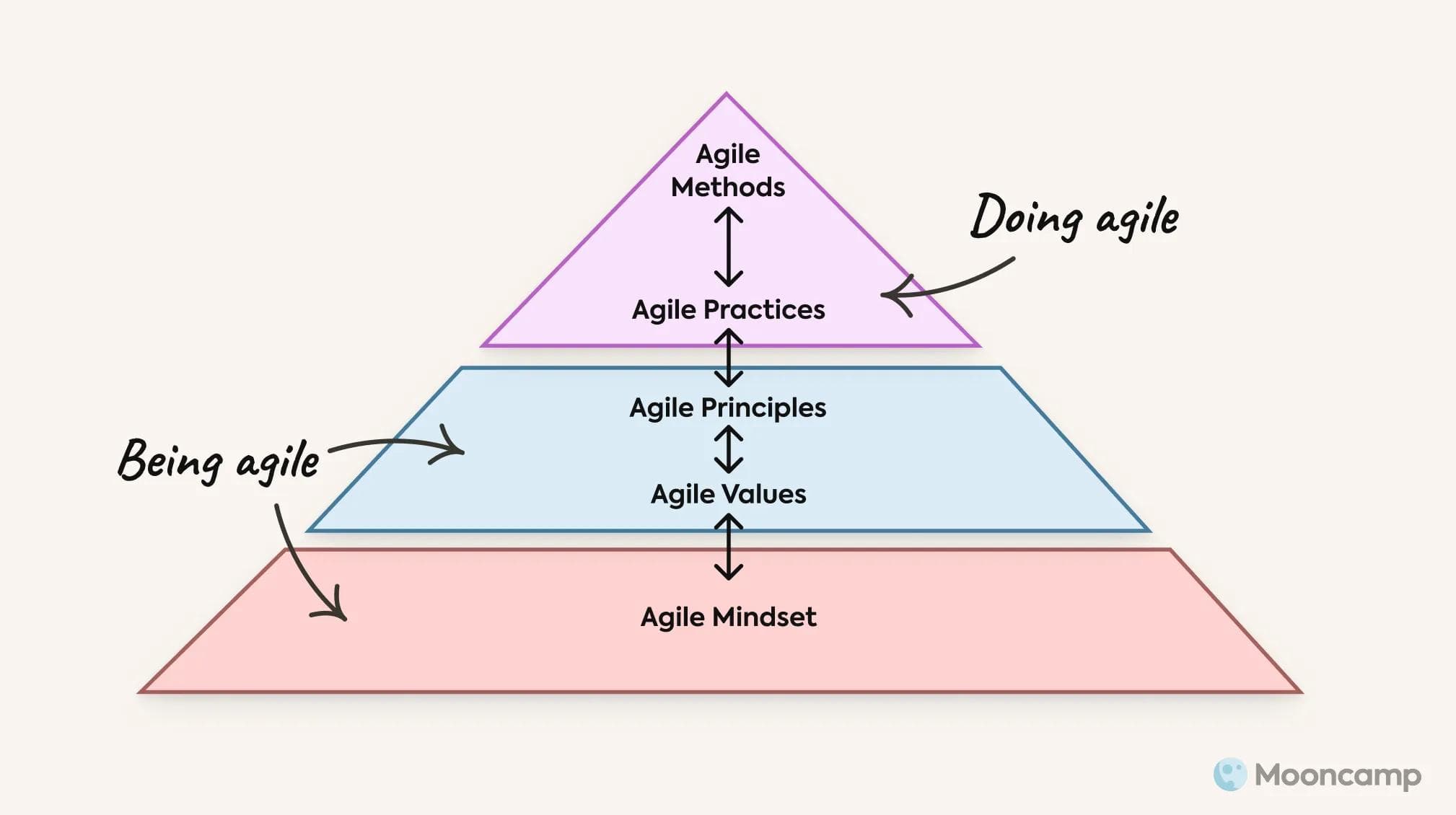
The 3 biggest misconceptions about the agile mindset
Because the agile mindset is something that is not immediately apparent from the outside and is difficult to grasp, misunderstandings occur time and again in practice:
- ❌ The agile mindset is equated with agile values and principles. In fact, however, they are different levels: Mindset defines values, values lead to principles, and principles shape behavior.
- ❌ The agile mindset is not promoted. An organization often expects its employees to be “more agile” – without simultaneously changing itself and providing the necessary structures, processes, and resources. An agile mindset calls for all levels of an organization to pull together to make it work in the long run.
- ❌ Mindsets can be changed quickly. This assumption is just plain wrong. Companies that expect short-term results when it comes to the agile mindsets of their employees will be disappointed sooner rather than later that things only change slowly. Forming a mindset is always an ongoing process that takes place day by day. Learning processes in the brain cannot be accelerated by pressure.
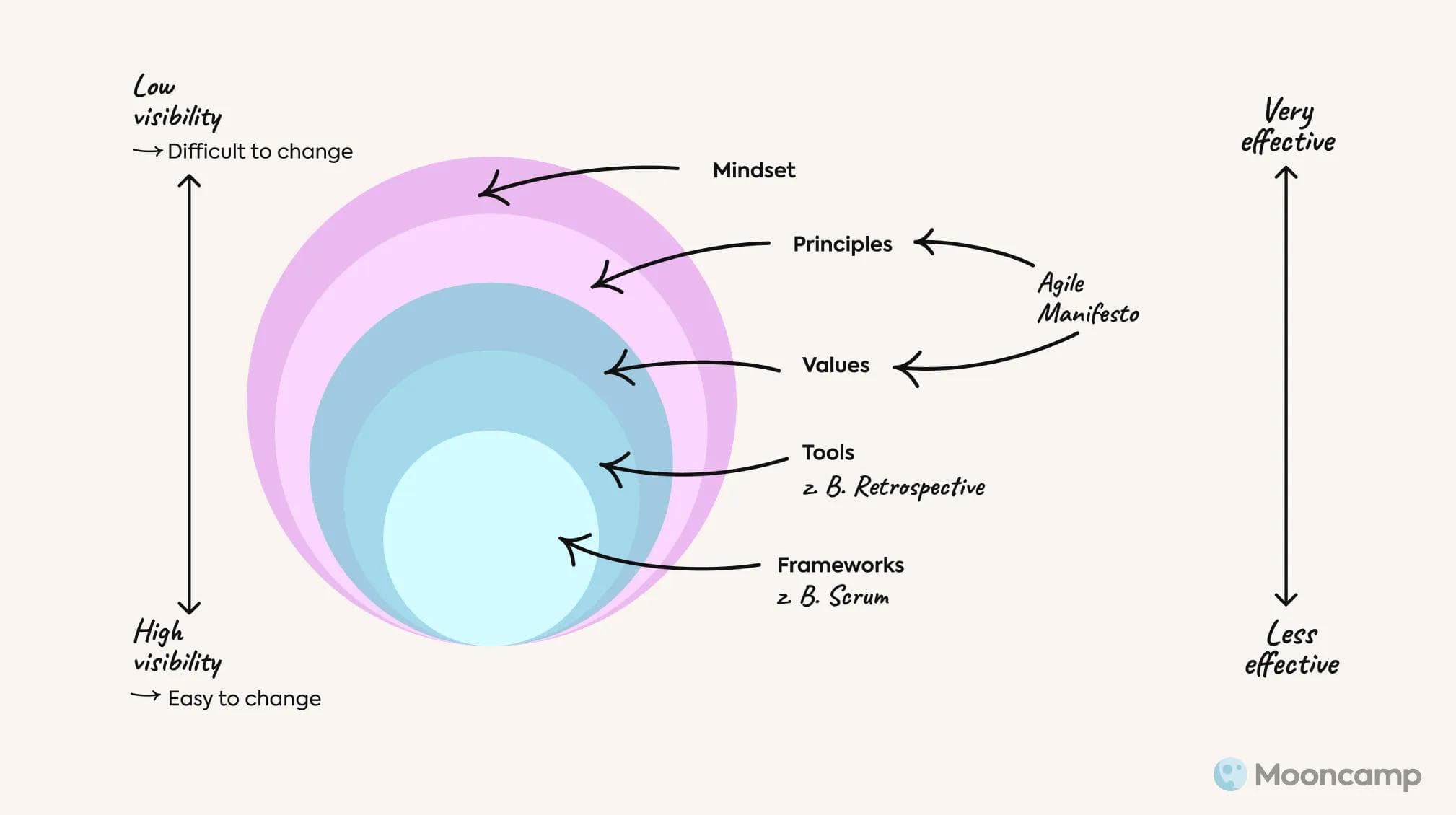
Developing an agile mindset as a company
The increasing globalization and digitalization of our working world means that a paradigm shift is currently taking place in many companies. The way organizations work is changing or needs to change to keep up with developments.
The basis for this is an agile mindset that is anchored in the corporate culture and shapes thinking and acting at all levels of the company.
But how exactly do organizations succeed in developing such a mindset and an agile work environment?
The 5 trademarks of agile organizations
According to management consultants McKinsey, the key to success lies in the right mix of dynamism and stability: agile organizations use a mindset shift to create stable basic elements that evolve slowly, while at the same time ensuring that they can act dynamically and adapt quickly to new challenges and opportunities.
In short, they think and act like a living organism rather than strictly hierarchy-driven and specialized like well-oiled machines.
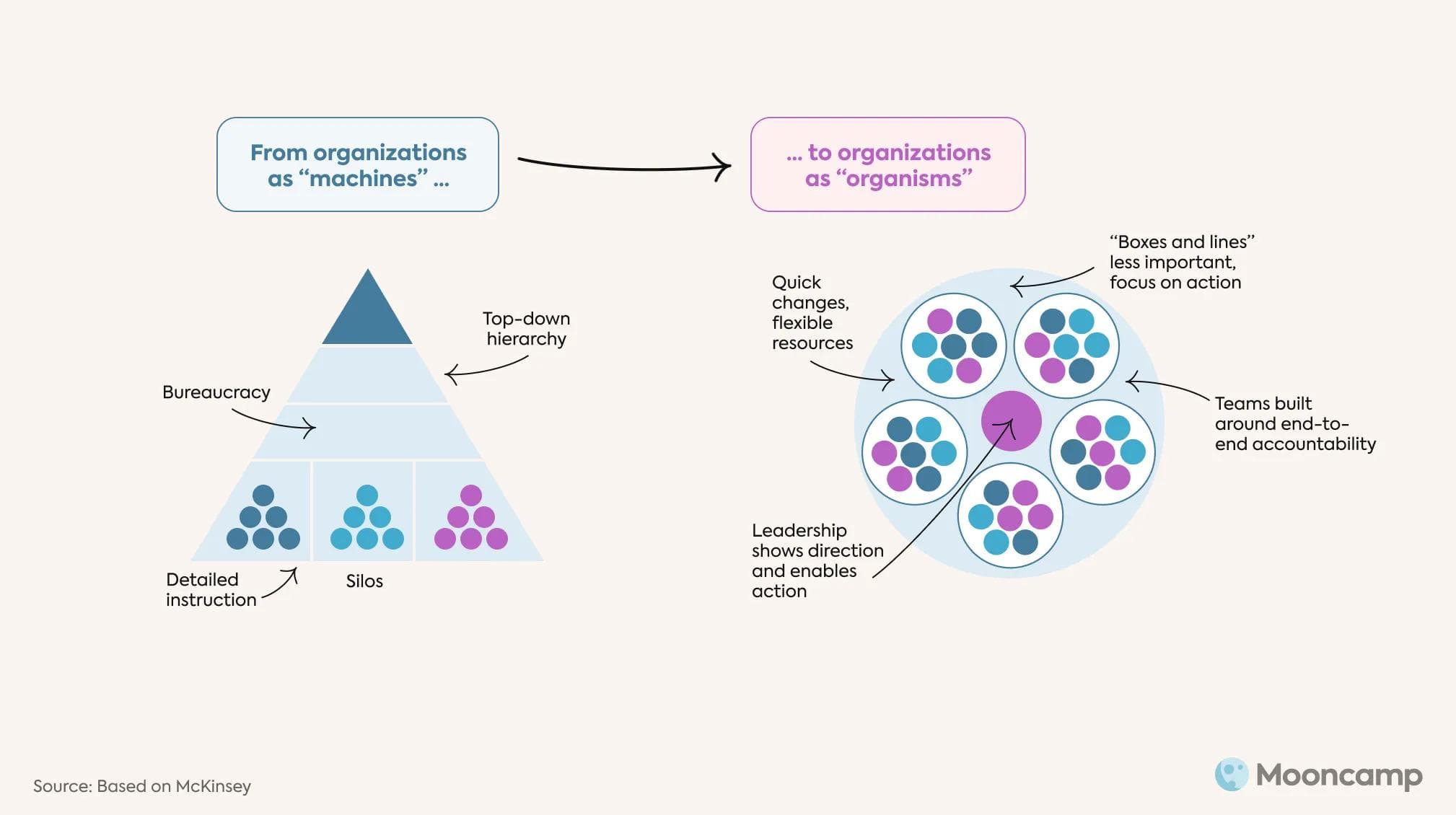
The five basic elements of agile organizations that companies looking to become more agile can work on are:
- ♟️ Strategy: There should be a clear vision and goal for the entire organization.
- 🔄 Structures: A network of empowered teams should work together toward this goal.
- ⚙️ Processes: Daily business should be structured in a way that allows for quick decisions and learning processes.
- 🧑 People: The team should consist of dynamic and passionate employees.
- 💻 Technologies: Future-proof technologies should be seamlessly integrated into the company.
Genuine agility only emerges when all five elements are present in an organization and reasonably linked with each other.
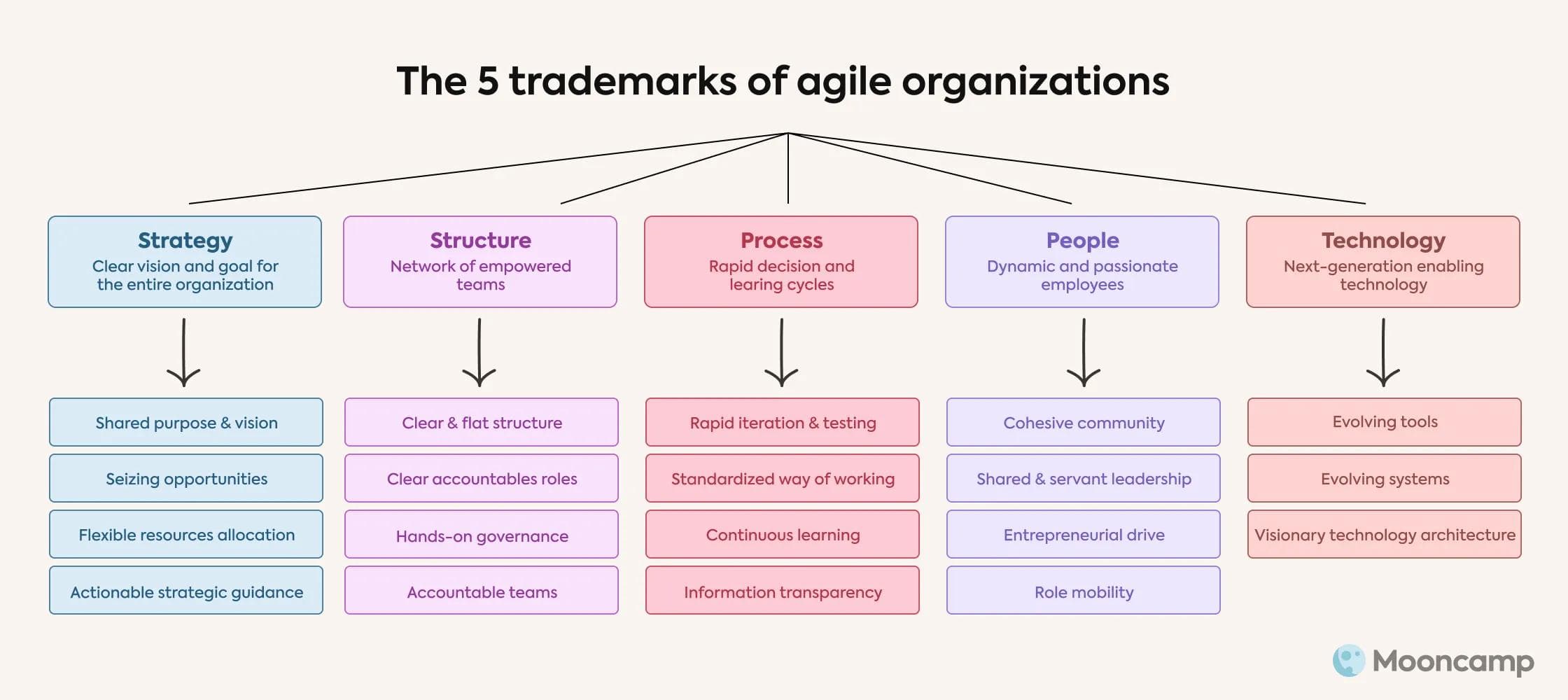
Old vs. new mindset: 5 steps for more agility
In order to set up organizational agility and acquire these central characteristics step by step, you need to change your way of thinking at all levels. If this shift in thinking succeeds in all five areas, an organization with an agile mindset will emerge.
1. Strategy: A mission statement for the entire organization
The goal in strategy is to change the mindset from “We are successful because we siphon value from competitors, customers and suppliers for our shareholders.” to this thought:
We use all opportunities and resources available to us to create value together with and for our stakeholders.
💡 How it works:
If you want to become agile as a company, you should think about two things: who you want to create value for and how you do it. The results of these considerations should be recorded in a mission statement, a shared vision. Make sure that all employees understand it.
In the daily work of an agile organization, the focus should always be on identifying and meeting the various needs of customers. This can be achieved by continuously obtaining feedback from all relevant stakeholders and incorporating it into the development of products and services.
2. Structure: A network of empowered teams
Building a network of empowered teams within an organization requires a shift in thinking from “People need leadership, otherwise they don't know what to do. They only care about themselves and chaos reigns.” to:
Employees are highly motivated, help each other, and deliver exceptional results when given responsibility.
💡 How it works:
Instead of rigid hierarchies, agile organizations rely on flat structures and a flexible, scalable network of self-organizing teams. Building and maintaining this network as well as ensuring that collaboration actually works is the task of managers.
Within this network, all employees should have clear roles and responsibilities. They should also be empowered to make their own decisions in day-to-day business. That way, they can focus entirely on getting their tasks done instead of wasting time and energy on unclear, overlapping responsibilities or waiting for superiors to approve every detail.
3. Processes: Quick decisions and learning processes
When it comes to processes, employees within an agile organization should move away from thinking, “Top management needs to detail what we want to accomplish and exactly how we're going to get there with minimal risk.” and instead shift to the following mindset:
In an environment that is constantly evolving, you are most successful when you embrace uncertainty and test new ideas as quickly and effectively as possible.
💡 How it works:
Companies with an agile mindset are working in fast cycles and experimenting with new approaches. Instead of spending weeks or months honing the perfect product, they develop an initial version of a product or service, which is then continuously refined and optimized based on direct feedback from the target group.
One prerequisite for this is that all employees communicate and share information openly and transparently. Knowledge must not be held back in silos; everyone should have quick and easy access to any information they need to perform their tasks.
Continuous improvement, whether from one's own or others' successes and failures, should be an integral part of everyday work. All agile team members should continuously optimize their individual working methods as well as the processes within the company.
4. People: Dynamic and passionate employees
In terms of people, the main issue is to change the way leadership is perceived. Instead of “Leaders need to control and direct their employees by giving them tasks, otherwise we won't get the results we want.” it should be:
Good leaders empower their employees to take responsibility and trust them to drive the shared vision.
💡 How it works:
Agile organizations put people at the center, engage all employees, and empower them to create value quickly, collaboratively, and effectively. Managers are responsible for supporting and developing their employees and creating a corporate culture in which they can realize their full potential. Instead of planning, dictating and controlling, they take on a coaching, supporting role, motivate their team and lead by example.
5. Technology: Technologies of the future
Last but not least, for true agility, the view of technology use should change. Instead of “Technology supports with services, platforms, or tools, and does so depending on priorities, resources, and budget.” the following thought should be ingrained in minds:
Technology is seamlessly integrated into the business and essential to create value and respond quickly to stakeholder needs.
💡 How it works:
In order to offer products and services that meet the rapidly changing needs of customers and competitive conditions, technologies, systems and tools are needed that are up to these new challenges. This could be, for example, cloud-based services or new tools for location-independent real-time communication and project management.
Practical check: How can companies tell if they have an agile mindset?
Now that it's clear what it takes to develop an agile mindset as a company, the question that remains is how organizations can tell if they've achieved organizational agility.
To assist with this, we have compiled a few questions that help to critically examine whether a company actually operates in an agile mindset:
- Is there a clear, shared vision?
- Is customer satisfaction at the center of every decision in day-to-day business?
- Are existing structures being called into question?
- Have old hierarchies really been dissolved? For example, are decisions supported by all team members and not just dictated by opinion leaders?
- Are mistakes used as an opportunity to learn instead of being condemned?
- Are successes celebrated and seen as a source of inspiration?
- Do all employees take responsibility for their field of work?
- Are feedback and criticism regularly requested?
- Are challenges really seen as opportunities?
- Is there a trusting, appreciative working atmosphere within the team?
- Are tasks distributed by project or continue to be assigned on a day-to-day basis?
- Are creative ideas and solutions appreciated in meetings, for example?
- Is knowledge and experience openly shared by everyone in the team?
Conclusion: Doing agile vs. being agile – a matter of mindset
In summary, an agile mindset is the foundation for agility. It becomes visible on several levels: in everyday life and in the workplace, in the way we see ourselves and the perception of others.
The answer to the question of whether a company is truly agile or merely working agile depends on whether the concept of agility is not only visible in implementing new, agile working methods, but has also arrived in the individual mindset of all employees. It is therefore not enough to simply introduce an agile framework and require employees to “operate in an agile manner” from now on.
Becoming agile as a company also requires a fundamental mindset shift. Old ways of thinking must be thrown overboard and new ones must be anchored in everyday work through constant application. Organizations can follow the five trademarks of agile organizations and gradually introduce suitable agile practices to strengthen the new, agile way of thinking. If this basis is in place, the agile transformation can succeed and agile methods such as Objectives and Key Results can develop their full potential.
Agile mindset – FAQ
What are the characteristics of an agile mindset?
The most important components of an agile mindset are flexibility and adaptability. People with an agile mindset respond quickly to change, see challenges as opportunities, and are constantly learning.
How do you practice agile mindset?
Agile behavior is manifested in actions that are directed toward the outside world. The basis for agile behavior is an agile mindset. Finding an innovative solution to a problem rather than relying on established methods would be an example of practicing an agile mindset.
Why is an agile mindset important?
An agile mindset is important because today, more than ever, everyday work is full of unforeseen changes and challenges. People and organizations with an agile mindset are able to master them. They are good at responding to change, able to find creative solutions and always focused on growth. For organizations, an agile mindset can also lead to higher employee satisfaction and stronger employee loyalty.
